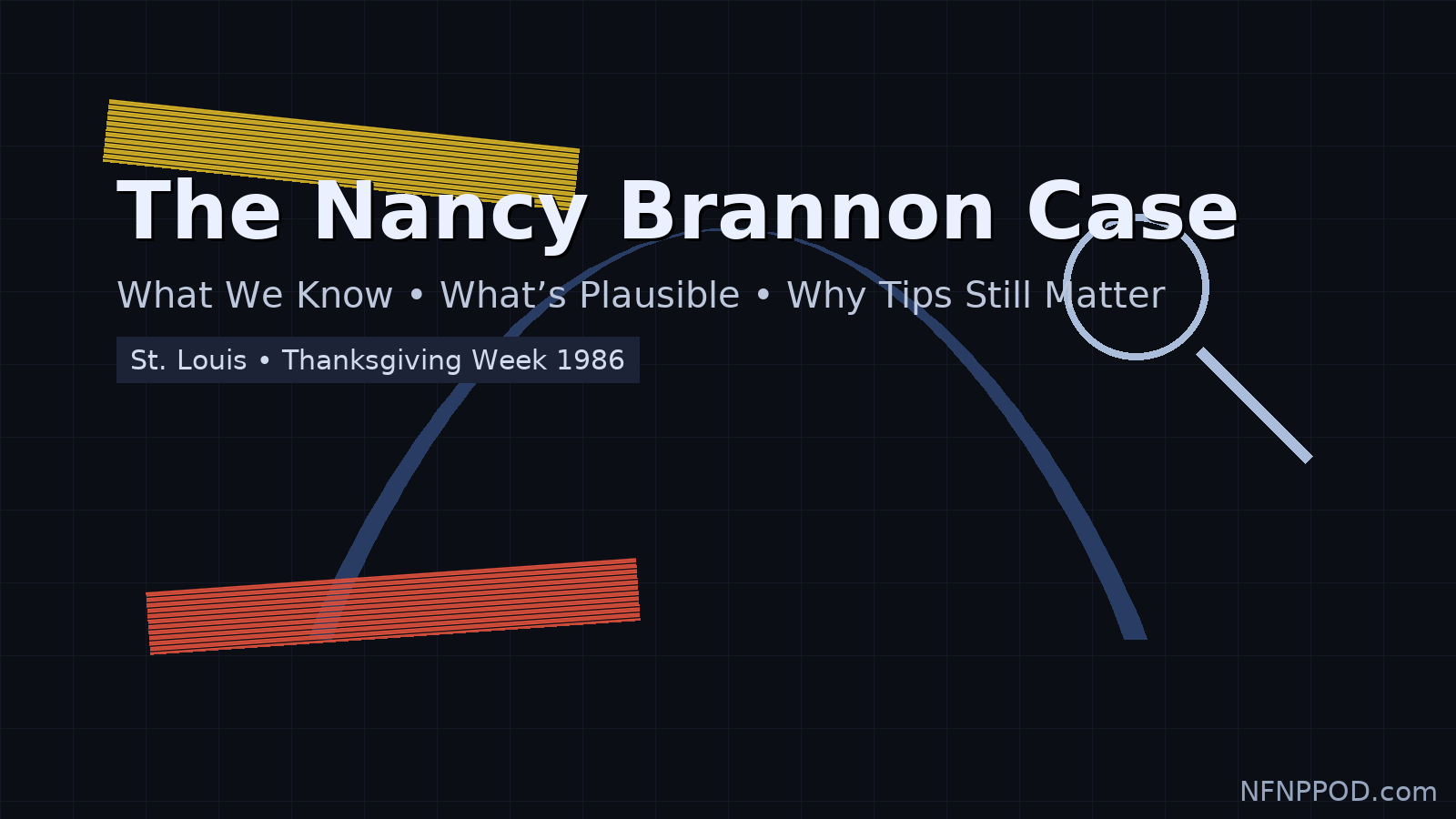The Nancy Brannon Case: What Still Keeps Me Up

The Nancy Brannon Case: What Still Keeps Me Up
I can’t shake the story of Nancy Leah Brannon. She was 34, it was the week of Thanksgiving 1986, and she vanished between a south city night out and her apartment in Shrewsbury. Nearly four decades later, her family is still living with a question mark where a person should be. I keep coming back to the details, because the details feel like they should add up to something.
Nancy spent that Tuesday evening around Grand and Delor, dinner, a couple of drinks, the kind of mid-week hang that shouldn’t become a life sentence of uncertainty for a family. Sometime around midnight she headed home. The next morning her 1983 Dodge Charger was sitting in the lot at her Watson Road apartment complex. A neighbor found her purse on the ground and turned it in. Inside, there was an empty birth-control pack from October. Police later found the November pack, picked up that same day, still unopened in the car. Her bed was made. The clothes she wore the night before weren’t in the apartment. All of that suggests what no one wants to admit: she probably didn’t make it inside.
There’s a witness story I can’t shake either. A worker from Marinati’s, a nearby spot, remembered a car backed into a space with the engine running around 11:30 p.m., right when Nancy would have been getting home. They thought it looked like an older Ford. Is that the linchpin? Maybe. Or maybe it’s just an eerie coincidence. But “backed in, engine running” reads like intent to me. It reads like someone planning a quick exit.
From there, the official record gets thin and the family’s memory has had to carry the load. Shrewsbury Police handled the case. The investigation stalled early, which is a sentence you can write about too many cases from that era. The family started working their own leads. Over time, a more complicated picture emerged. Relatives say a coworker confided that Nancy had been involved with a married colleague. He was a pharmacist, building a house with his wife. Police interviewed him back then. His alibi was his wife. No polygraph. No arrest. Decades later, the family learned he’d moved through several states and is now in Myrtle Beach. Is any of that proof? No. Is it the kind of detail that should be boxed, labeled, and revisited with modern tools? Absolutely.
Here’s what’s solid: the car where it shouldn’t be, the purse where it shouldn’t be, a home that looks untouched, and a narrow window between “leaving the bar” and “not making it inside.” Here’s what lives in the gray: that backed-in car, the relationship angle, the possibility of a pregnancy (raised by family, dismissed by an investigator at the time). And here’s what was new in 2025: Shrewsbury Police spent two weeks in Oakville with cadaver dogs, ground-penetrating radar, and soil probes on a residential property tied to someone from Nancy’s orbit back then. They dug, they scanned, they left without a public announcement of findings. That doesn’t mean nothing’s there; it means nothing they’re ready to say yet.
When I lay the puzzle pieces out on the table, a few plausible stories take shape:
One, someone Nancy knew intercepted her as she got home. The car is where it belongs, the purse is nearby, but the apartment never shows signs of her return. If you’re trying to make it look like she arrived safely, that’s exactly how you stage it. The backed-in car with the engine running could fit that, too.
Two, the danger happened off-site, and the car was brought back later. If Nancy left the Grand and Delor area with someone she trusted, returning the car to Shrewsbury would shift attention away from the city. That would also explain why no one in the complex heard a struggle and why the apartment reads like a snapshot from the morning before.
Three, the nightmare we all know is possible: a stranger crime of opportunity. Late night, 1986 lighting, a woman getting out of her car. You don’t need an elaborate backstory for something evil to move fast. The running car could be unrelated. Or it could be the whole story in one image.
I’m not here to name a suspect. Law enforcement hasn’t, and neither should we. But I am here to say this case is solvable if the right memory, the right name, or the right scrap of paper resurfaces. If you tended bar, waited tables, or were a regular at Halftime Saloon or Marinati’s that week, who left with Nancy? Who was waiting outside? If you lived at those Shrewsbury apartments, who drove a mid-’70s Ford and liked to back in? If you worked construction in Oakville in the mid-80s, who was building and talking too much at lunch? If you worked in pharmacy or medical sales, then who overlapped those worlds?
Sometimes the “nothing” you remember is the thing that breaks a case: a license plate pattern, a jacket with a company logo, a nightly routine, a nickname, a remodeling timeline, a receipt tucked inside an old day planner. Families don’t need perfect memories. They need one that points to the next door.
Technology gives us a better shot than Nancy’s family had in 1986. Databases like NamUs exist now. Cold case detectives work with tools that weren’t even ideas back then. Media spotlights in 2023–2025 have already pushed this case back into public view. And that Oakville search tells me Shrewsbury PD is still out there turning over ground, not just pages.
I think about Nancy’s grandparents dying without answers, about holidays that feel like anniversaries of absence, about a family that learned to be cautious because safety suddenly felt negotiable.
After thirty-plus years, closure doesn’t arrive by accident. It shows up because someone decides today is the day they say what they remember.




